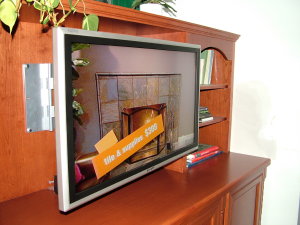Home Improvement Television
DEAR TIM: I once was an addict to home improvement and home design television shows. I would watch these shows for hours and then try to recreate what I saw on the screen. My results were always pitiful and my jobs were one problem after another. I never saw significant problems during any of the shows. What am I doing wrong? Are the shows a slice of reality or did all of that get left in the editing suite at the television production studio? Amy H., Little Rock, AR
DEAR AMY: One word describes the source of your confusion: Money. The home improvement television industry is awash in a vortex of money that seems to be endless. The producers of the shows you probably watched as well as the different networks that air the shows are just practicing old-fashioned marketing in my opinion. They know that many people love to dream and they especially love to be shown real images of things that they want. The appetite for this programming is probably as deep as the bottomless pit of sponsorship dollars that make the shows possible.

This LCD television screen really shows high-definition resolution. But even with that, don't think you will be able to achieve professional results when you try to do projects on your own. PHOTO BY: Tim Carter
The trouble you may be encountering is rooted deeply in the philosophical purpose of the actual television programming. Many of the shows are made to be purely entertainment while some intend to be highly instructional. Add to this the fact that some shows are a mix of the two.
The entertaining shows are very good at showing you the before, some of the during and the luxurious after footage of the completed project. But don't be fooled, not for a moment. If you think the level of craftsmanship and quality is extremely high on all of the projects, you are dreaming.
Don't beat yourself up over some of the flaws in your work. If you and I were invited to the places where some of these shows are filmed on the day the final footage was being shot, I guarantee you we could find flaws and errors in the workmanship. The camera lenses don't always take close-up shots of detail work. Frequently the shots you see in the final show are wide-angle and your brain fills in the details. This exact same thing is true in magazine photos. Your brain will easily create a highly-focused image in your head of the final results that may or may not match what your eyes are actually seeing.
In all fairness to the television show producers, they are working on tight budgets. They only can devote so much time to creating a show. Significant amounts of money are spent in pre and post production activities. These are planning and editing tasks that must be done before and after the actual footage is taped on the job location.
Add to this the aspect of show time. The 30 minute program you watch on cable television might only be 21 or 22 minutes of actual programming. The rest of the time is filled with commercials that make the show possible. If you think you can really teach how to remodel a kitchen in 22 minutes covering all of the important tasks, you better think again. It would take many hours of programming just to scratch the surface of all of the individual tasks that must be done to transform an ugly kitchen into a showcase room.
As for the reality of the shows, I feel that much of that is simply ignored. Sure, you see some of the actual work happening, but you don't see all of it and for sure you don't see all of the serious goof-ups. That simply would not make great programming for certain shows. The producers want to project happiness, not misery, disappointment and financial loss. If that is what they showed all of the time, people like you might stop watching. Remember, television is almost always about entertainment, not "real" reality.
The actual process of taping home improvement television shows is extremely time consuming. To get very high-quality footage, several takes of each scene are the rule, not the exception. On rare occasions, the field director and producer will be happy with the first take, but they almost always want several takes. Tasks have to be done repeatedly by the talent so that both wide and close-up shots are taped. This extra tape footage is often referred to as B-roll. It can take hours to produce all of the needed B-roll footage for a simple 30 minute television show.
Lighting and sound issues are also critical. Rarely will you see a light tower or filter screen in a finished television show. But believe me, there are often many lights, cables, filters, reflectors, etc. just off camera. Rogue sounds and noises produced by things near the actual taping can cause a perfect shot to be redone. It might be an airplane, a loud motorcycle, a distant firetruck or a neighbor starting a lawn mower. Remember, you just see the final 20 minutes or so of programming, not all of the bumbled lines, mistakes made by the talent, or other pieces of footage that simple don't want to be shown by the producer.
Column 581